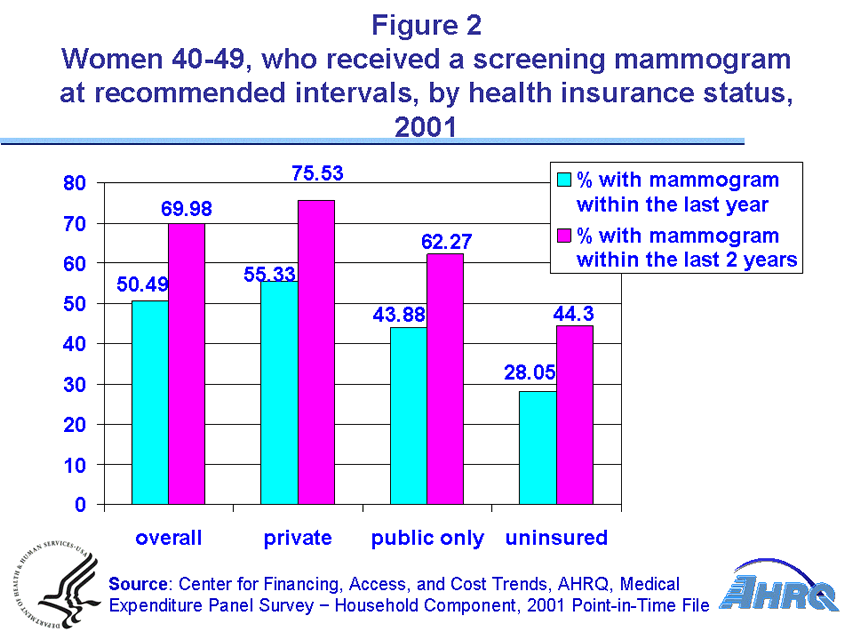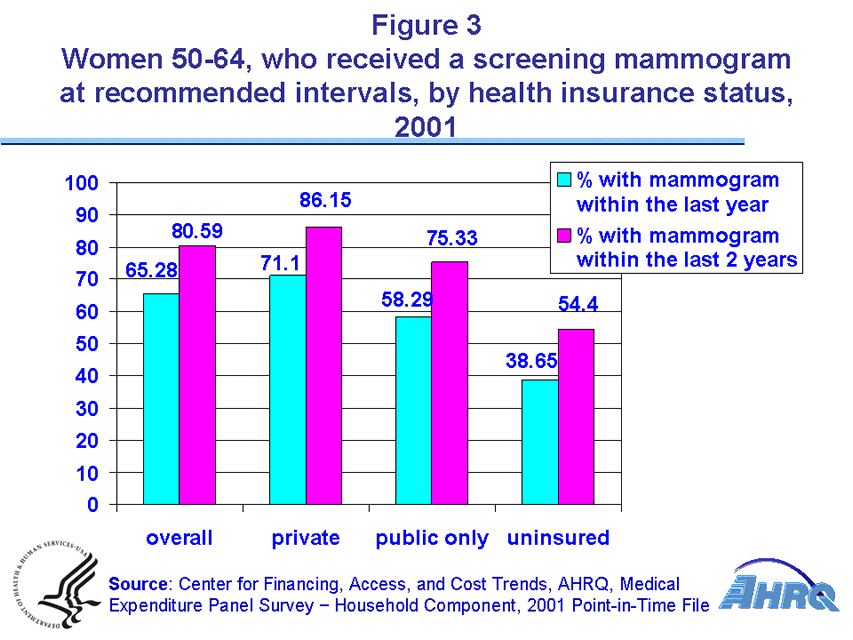
|
|
Font Size:
|
||||
|
|
|
|
||||
STATISTICAL BRIEF #22:
Use of Mammography as a Cancer Screening Tool, 2001
Briefly Stated
- Three quarters (75.4%) of women 40-64 received a mammography screening within the last 2 years.
- Women covered by private health insurance were more likely to obtain mammography screening exams than those covered by public insurance only or lacking insurance coverage entirely.
- Older women, 50-64, had a consistently higher rate of mammography screening compliance than younger women, 40-49, regardless of health insurance status.
Introduction
Mammography can help locate cancers too small to be detected during a clinical breast examination. Recommendations exist regarding the appropriate intervals for obtaining routine mammography screening in women over 40 to detect early breast cancer. The U.S. Preventive Services Task Force (USPTF) guidelines recommend mammography screening every 1-2 years for women aged 40 and older. The American Cancer Society (ACS) recommends mammography screening annually for all women over 40.
Health insurance coverage is a factor associated with an individual's utilization of health services, and it may also be associated with access to and use of preventive services. This report examines the relationship between health insurance coverage status in the first half of 2001 and mammography screening rates among women between the ages of 40 to 64 in the U.S. civilian non-institutionalized population in 2001.
Findings
Based on preliminary data from the 2001 MEPS, almost 60 percent (58.0%) of women 40-64 in the United States received a mammography screening within the last year while three quarters (75.4%) had been screened for breast cancer within the last 2 years (Figure 1). Relative to younger women, older women were more likely to have obtained mammography screening. Approximately 70 percent of women aged 40-49 received a mammography screening in the past two years versus 81 percent (80.6%) of women 50-64 (Figures 2 and 3).
There was significant variation in mammography screening rates by health insurance coverage status. Approximately 75 percent (75.5%) of women aged 40-49 with private coverage received a mammography screening in the past two years, compared with 62 percent (62.3%) of women with public-only coverage and only 44 percent (44.3 %) of the uninsured (Figure 2). Rates of mammography screening also varied by insurance status for women aged 50-64.
Approximately 86 percent (86.2%) of women aged 50-64 with private coverage received a mammography screening in the past two years, compared with 75 percent (75.3%) of women with public-only coverage and 54 percent (54.4%) of the uninsured (Figure 3).
About MEPS
The estimates in this Statistical Brief are based on preliminary data from the 2001 Medical Panel Expenditure Survey Household Component (MEPS-HC). This data set contains a sample of 34,173 persons with a response rate of about 71.4%. The MEPS is a nationally representative longitudinal survey that collects detailed information on health care utilization and expenditures, health insurance, health status, as well as a wide variety of social, demographic, and economic characteristics for the civilian non-institutionalized population. This Statistical Brief examines the preventive care data that were collected in Rounds 3 and 5 of the MEPS survey. The health insurance coverage information in this Statistical Brief pertains to the first half of 2001. Missing data for mammography ranged from 2-3%, and were excluded from the analysis. All results presented in this statistical brief are statistically significant at the .05 level. More information about MEPS can be found at the MEPS web site at http://www.meps.ahrq.gov/.
For a detailed description of the MEPS survey design, sample design, and methods used to reduce sources of nonsampling error, see the following publications:
Cohen, J. Design and Methods of the Medical Expenditure Panel Survey Household Component: Rockville (MD) Agency for Health Care Policy and Research; 1997. MEPS Methodology Report No. 1. AHCPR Pub. No. 97-0026.
Cohen, S. Sample Design of the 1996 Medical Expenditure Panel Survey Household Component. Rockville (MD) Agency for Health Care Policy and Research; 1997. MEPS Methodology Report No. 2. AHCPR Pub. No. 97-0027.
For more information on current guidelines for cancer screenings refer to the following sources:
Guide to Clinical Preventive Services, Report of the U.S. Preventive Services Task Force, 3rd Edition: Periodic Updates (available Winter 2002/03) Screening for Breast Cancer, 2002
USPSTF guidelines are also available at http://www.ahrq.gov/clinic/cps3dix.htm
 |
|||||||||||||||||||||||||
|
|||||||||||||||||||||||||
|
|
|||||||||||||||||||||||||
 |
|||||||||||||||||||||||||
|
|||||||||||||||||||||||||
|
|
|||||||||||||||||||||||||
 |
|||||||||||||||||||||||||
|
|||||||||||||||||||||||||
|
|
|||||||||||||||||||||||||


